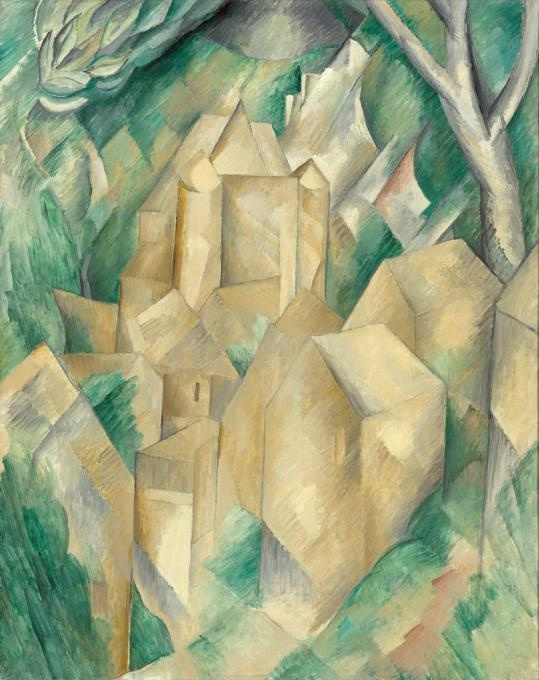log in
Enter site
Login to use Arthive functionality to the maximum
The New Castle at La Roche-Guyon
Georges Braque • 绘画, 1909, 92×73 厘米
画作描述 «The New Castle at La Roche-Guyon»
Before leaving for compulsory military service, George Braque took a short trip. While travelling, he created some pictures that art historians qualify as proto-Cubist. It was no longer figurative art as we commonly understand it (though the objects in the canvases are quite recognizable), nor was it true Cubism which it would become in a couple of years. The New Castle at La Roche-Guyon is one of the five works he painted during the trip and dedicated to the tumbledown building of the 12th century located on a chalk cliff.
Not for nothing did George Braque become one of the most prominent figures in the world’s art of the twentieth century. Like his companion Pablo Picasso, he was a tireless experimenter. His earliest works were Impressionist, but quite soon, he found that his true self was Fauvist. Paul Cézanne was one of his favourite painters to be followed in art. He did not stay long in Fauvism, though. There is no clear evidence which of the two, Braque or Picasso, was the first to paint a Cubist picture. Side by side, they developed their art, discussing new painting methods and sharing ideas. Both the painters went through short periods of transition from style to style when features of different periods could co-exist in the same pictures. The La Roche-Guyon series is an example of this transition.
As soon as Braque arrived at the town of La Roche-Guyon on the Seine, the local castle immediately aroused his interest. That piece of architecture was a perfect object for proto-Cubist experiments. Each of the five paintings portraying the castle is slightly different from the previous ones. Braque achieved curious effects experimenting with planes and their tinting. In this picture, the castle seems both a construction of wooden blocks and a funny-shaped crystal growing on a cliff. Even though the image is far from realistic, it seems surprisingly palpable and three-dimensional. It was one of Braque’s objectives — to ‘tame’ the space and make it material.
Not for nothing did George Braque become one of the most prominent figures in the world’s art of the twentieth century. Like his companion Pablo Picasso, he was a tireless experimenter. His earliest works were Impressionist, but quite soon, he found that his true self was Fauvist. Paul Cézanne was one of his favourite painters to be followed in art. He did not stay long in Fauvism, though. There is no clear evidence which of the two, Braque or Picasso, was the first to paint a Cubist picture. Side by side, they developed their art, discussing new painting methods and sharing ideas. Both the painters went through short periods of transition from style to style when features of different periods could co-exist in the same pictures. The La Roche-Guyon series is an example of this transition.
As soon as Braque arrived at the town of La Roche-Guyon on the Seine, the local castle immediately aroused his interest. That piece of architecture was a perfect object for proto-Cubist experiments. Each of the five paintings portraying the castle is slightly different from the previous ones. Braque achieved curious effects experimenting with planes and their tinting. In this picture, the castle seems both a construction of wooden blocks and a funny-shaped crystal growing on a cliff. Even though the image is far from realistic, it seems surprisingly palpable and three-dimensional. It was one of Braque’s objectives — to ‘tame’ the space and make it material.


